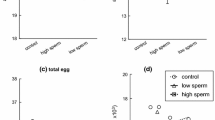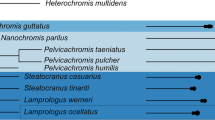Abstract
To determine how fertilisation varied with sperm concentration for two species of scallop, Chlamys (Equichlamys) bifrons (Lamarck) and C. asperrima (Lamarck), we performed a simple series of sperm dilution experiments, and measured egg size and sperm swimming speeds. C. bifrons eggs were much larger (average diam=116.5 μm), and sperm swimming speeds faster (209.8 μm s−1), than C. asperrima (71.2 μm, 166.0 μm s−1). In both species, maximum fertilisation occurred at an ambient sperm concentration of around 100 sperm μl−1; the maximum proportion of eggs fertilised was less than 0.70 in the C. bifrons experiments, but nearer 1.0 with C. asperrima. At high sperm concentrations (>100 sperm μl−1), fertilisation decreased (presumably due to polyspermy) with increasing sperm concentration, but decreased more rapidly in C. bifrons than C. asperrima. A polyspermy-adjusted fertilisation kinetics model could be fitted to the experimental data, but unique parameter estimates could not be determined.
Similar content being viewed by others
Author information
Authors and Affiliations
Additional information
Received: 7 October 1999 / Accepted: 8 July 2000
Rights and permissions
About this article
Cite this article
Styan, C., Butler, A. Fitting fertilisation kinetics models for free-spawning marine invertebrates. Marine Biology 137, 943–951 (2000). https://doi.org/10.1007/s002270000401
Issue Date:
DOI: https://doi.org/10.1007/s002270000401




